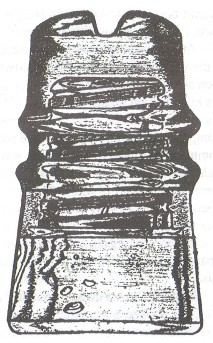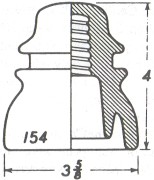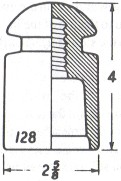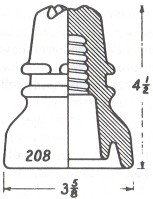Searching the A.T.&.T. Northern Transcontinental Toll Lead
by Mark Heitman
Reprinted from "Crown Jewels of the Wire", July 1992, page 9
The Stampede Pass Trips from 1978 to 1983
Part B
(We pick up the story where we left off in the June, 1992 issue, p. 21)
The first time I went to Cabin Creek a house had four whole but stress
cracked California purple 208's in the window. BINGO! I must be close to the
Transcon. I went over and knocked on the back door. A middle-aged gentleman
answered and I inquired if the toll lead went through the area? And that I would
like to find some crosstops like he had in his window. He kind of chuckled and
said: "You're on it". He then pointed about 30 feet behind his house
and said the old line went East and West from that point. He told me though,
"I doubt if you'll find anything as the line was thoroughly searched about
10 years ago." Well, being a stubborn German that I am, I kindly thanked
him and down the lead I went.

I went about 6 blocks and found nothing but broken pieces of glass. Then
hiding in the ferns, just as nice as if the Easter Bunny himself hid this one,
was a nice medium aqua straight-up. l will always remember this one because in
the top it has a piece of sand that looks like a small white worm curled up in a
circle. I just knew that there had to be more stuff out there that others had
missed and I really wanted to get one of those California 208's. I followed the
line about another half of a mile and came to a hill that was about 150 feet
steep. I recalled what Andy and Vi had told me about hill hunting: "Get
real low to the ground and scan back and forth as you go up the hill." They
said that they had found a lot of glass in this manner. So I started scouring
the hill really good. First across and then back, then up and down, and finally
diagonally. I'm sure glad I was alone, if someone would have seen me searching
the place in this way, they would have probably thought one of two things.
Number one, I've lost something real small in a haystack. And it's going to take
me the rest of my natural-born days to find it. Or Number Two, I'm half looney
without a tune!
After searching half way up the hill, in the middle there was a small one to
two inch hole going straight into the side of the hill. At first glance I
thought, "Oh, just a varmint hole." But then something just a little
odd caught my eye and commanded a double take. The sunlight was shining off of
something in there. Being kind of leery, I took my potato rake and I was really
nervous, fearing that maybe a weasel or a snake would come leaping out at me. Or
maybe a badger...just what I'd need at a time like this.
But as I cleared the stuff out of the way, out popped a beautiful California
208. And it started rolling down the hill. I instantly dove on top of it. I
didn't want it going down the hill for fear it might hit one of the many rocks
that dotted the hill. Once I got it out from underneath me and cleaned off the
dirt, there was a beautiful light smoky purple three-eighths inch high lettered
California. It was mint except for one small upper wire groove chip. I was
delighted beyond my wildest expectations. Just to think I found one of those
purple crosstops that the gentleman at Cabin Creek said were now gone by the way
side.
Well, I stopped hunting for the day and couldn't wait to burn a path back to
Andy and Vi's to show them my newest treasure. When I got there, Andy was in a
really comical mood. He looked at it and said, "Oh, just another one of
those ol' lousy purple Californias." Vi said, "I'll bet you're just
ecstatic, beginner's luck is great, isn't it?" She said she felt the same
way when she found her first California. And to this very day I haven't had that
same feeling until I recently found 5 CD 141 's in Northern Idaho.
THE PIT
The next hunting season presented a new type of find, THE PIT. Just what is a
pit? It's where, due to fire danger, local ordinances, or just the Line
Supervisor's discretion, the lineman is required to bury the insulators. This
may be achieved in one of two ways. Dig a pit and throw them in or (the
preferred way) placing them in the old pole hole once the pole is extracted from
the ground. On Stampede both tactics were used. Most of the time though if
burial was to be implemented, they were placed into the old pole hole. Being a
former lineman myself, we didn't like to hand dig anything if we didn't have to.
This by far is the most difficult type of hunting one will encounter due to
the depth of the pole hole. Most of the pole holes are 4 to 6 feet deep and most
of the glass in these holes has 2 inches to 2 feet of dirt covering it.
I got lucky my first and only pole hole type of pit. I was near a wooden
water line that had a leak in it. It was probably putting out between 5 to 10
gallons of water every minute, thus creating a nice small stream. This stream
just happened to run right over where a pit was located. It uncovered the tops
of two aqua CD 154 Whitall Tatums. I almost ignored the pair thinking that they
were just two damaged ones thrown there by some one who had dug a nearby pit.
But things were a little slow that day, so I thought I'd just check the two out
for condition or maybe some defects in manufacturing. I pulled the two out and
behold two more pieces of glass were underneath those two. By this time things
were getting pretty muddy. So I had to stop and do a little stream diverting.

Once that was accomplished I got back to the middy situation at hand. I then
reached in and pulled out several Pyrex CD 128's. Some were damaged and some
were mint. I now found myself at about two feet down in the hole. I knew that
this one had to be a pole hole since the dirt was coming out of the hole in a
fairly easy manner. At this point I again had to stop and start pulling out the
water and mud as the sides of the hole were slowly oozing down onto the glass
still in the hole. "Man, was that water and mud COLD!!"

Once again I cleared out most of the muck and I started to go after the glass
again. Out came a broken Hemingray 44 crosstop, then another broken one.
However, the third piece out of the hole was a mint one except for a few broken
drip points on the bottom.
My efforts were starting to payoff.
I was now at about 3 to 3-1/2 feet down, and I began
to wonder if this thing was going to go to China. I only had about 6 inches of
arm left to pull insulators out with. I dug the other 6 inches real fast and was
now up to my shoulder in the cold goo. I could feel another piece down there,
but I tried for about 5 or 6 minutes to get it out until my arm felt like it was
going to fall off. The water and cold mud was now getting to be a real pain
since my arm was totally numb from the cold. I stopped and wiped my arm down
with my tee shirt to remove the mud and water and hopefully warm it up. I
couldn't believe how cold this stuff was. It was the middle of July and my arm
felt like it was in a Montana blizzard. I sat down on a nearby stump and lit up
a smoke and began to think of how I was going to get the rest of the glass from
the nasty grave they were in.
BINGO! The light came on! I'll use my rake and try
to get the tines under the pieces and lift them up and out of the hole. Even
this proved mighty difficult, as I tried to lift up the first piece the moving
mud and water would shift it off of the rake's tines and down to the bottom it
would go with a slight clunk when it reached the bottom and contacted another
piece of glass. It reminded me of one of those quarter machines you take the
steam shovel and try to retrieve a prize in the side hopper. Fortunately, I
didn't need a roll of quarters, just a real steady hand.
After a few more tries, out came a California 208. I
was really getting excited now. I took the piece off the tines and about one
third of the top was broken off. Rats! (There's a reason for this and I'll
explain it a little later on.) Meanwhile back down goes the rake for another
try. After sweeping around the hole again I bumped into another insulator. This
one proved even more difficult to remove than the previous one because the mud
is now really stirred up and the rake tines and the glass are really slick. I
finally managed to get the piece out and WOW! -- it's a another California 208,
but, like the first one, it too had massive damage with about half of it
missing.
Back down goes the rake for another try. I sift
around the muck and bump into one last piece. This one will definitely try my
patience. It's about four feet down and I don't have much of the rake handle to
maneuver the piece with. I also don't have any more insulators down there to
brace the piece up against while I put the rake tines underneath it to lift it
out. The piece kept moving around the hole. I would just get it on the rake and
start to move it and the slick muck would just slide it right off of the rake.
Then, of course, I would have to start the whole process over again, starting
with locating the piece in the muck again. After numerous tries I finally
managed to roll the piece up the side of the pole hole and out.

After rinsing off the mud I ended up with a real
nice almost mint light smoky purple California 208. It was kind of amazing that
out of three Hemingray 44 's, only one was mint and out of three California
208's only one of those was mint also. But, I was definitely a happy camper that
day. I just hope my next pit is a dry one.
Most of the California 208's that I've found on
Stampede were missing the top 1/4 to 1/2 part. It is my assumption that the
linemen would probably take a set of lineman's pliers and smack the insulator
just above the wire groove, thus making the job easier to remove the line wire
from the insulator. As most of the Californias were secured by the use of a two
tie wire arrangement, this prevented the line wire from sliding down the side of
the insulator and grounding out on the crossarm. In this method the line wire is
tied in the upper grooves on top of the cross-top rather than on the side wire
groove. This type of tie arrangement proved very successful in heavy snow and
ice areas like Stampede, because the weight of the mid-span snow and ice on the
line wire is now applied to the top of the insulator, rather than to the side of
it. Thus the whole top now takes the weight of the load. And even if a severe
overload were to be encountered the insulator would just drop down until the
insulator skirt rested on top of the crossarms, but the line wire would still
remain away from the crossarm and still be secured to the top of the insulator
and wouldn't ground out on the arm.
(TO BE CONTINUED NEXT MONTH....the last
Stampede Trip)
Drawings of CD 128, 154 and 208 are used with
permission of N.R. Woodward, The Glass Insulator in America, 1988 Report,
p. 71, 74 and 78.
| 